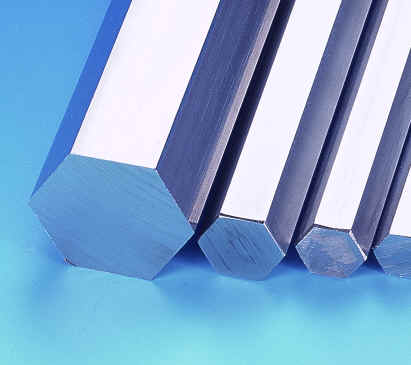Austenitic Hexagon Bar
Finish Metals | Stainless Steel

Austenitic Hexagon Bar
Stainless steel is an iron alloy with resistance to staining and rusting in many environments where steel would typically degrade. The chemical composition of each grade creates a grain structure that falls into one of five classes: austenitic, duplex, ferritic, martensitic, and precipitation hardening. The austenitic class contains the most formable, weldable, and corrosion-resistant stainless steel grades, but they cannot be heat treated.
Grade 304 is the most versatile and widely used stainless steel, available in a wider range of forms, products and finishes than any other. In fact, austenitic stainless steel is approximately 70% of overall stainless steel production. Austenitic stainless steel hexagon bar is not magnetic; due to its high nickel and chromium composition, it is the most resistant to corrosion of all the stainless steel groups. In addition, austenitic stainless steel hexagon bar provides excellent mechanical properties. Heat treatment cannot be used to harden austenitic stainless steel hexagon bar, although it can be hardened considerably by cold working.
Grades Available:
303
304/304L
316/316L
Primary Elements:
Typical austenitic stainless steel is 18/8 stainless, which is composed of 18% chromium and 8% nickel.
304/304L Stainless Steel Bar
UNS S30403 (Grade 304/304L)
304/304L stainless steel bar, also known as UNS S30403 and Grade 304/304L, is the low carbon content version of Type 304 generally preferred because it is the “free machining” version. Grade 304/304L exhibits good combination of strength, corrosion resistance and fabricibility making it ideal for almost all industries. Cold working will increase both the hardness and strength, and it does not respond to heat treatment. Used in every conceivable industry
The 304 stainless steel hex bar has an unpolished (mill) surface and a standard tolerance. The 304 stainless steel grade is a general-purpose material that combines corrosion resistance, weldability, and formability, making it the most commonly used grade of stainless steel. An austenitic stainless steel that is one of the 18-8 grades, 304 can be cold worked to increase its hardness and strength while maintaining most of its formability. The material is typically nonmagentic but may become slightly magnetic when cold worked.
Products partially or completely constructed of 304 include:
Architectural paneling, railings & trim, Chemical containers, including for transport, Food processing , equipment, Kitchen benches, sinks troughs, equipment & appliances, Woven or welded screens for mining, quarrying & water filtration, Springs, Threaded fastener.
303 Stainless Steel Bar
UNS S30300 (Grade 303)
The 303 stainless steel hex bar has an unpolished (mill) surface, has been annealed, meets American Society for Testing and Materials International ASTM A582 specifications, and has a precision tolerance. The 303 stainless steel grade offers better machinability than general-purpose 304 stainless steel with slightly less corrosion resistance. An austenitic stainless steel, 303 is typically nonmagnetic and can be cold worked to increase its hardness and strength while maintaining most of its formability. The material has been annealed, a method of heating and cooling metal to modify its properties, such as increasing its formability and toughness or decreasing its strength, after it has been shaped.
Product Features
303 stainless steel offers better machinability than 304 stainless steel
Unpolished (mill) surface has no finish
Meets ASTM A582 specifications
Annealed after shaping to modify the metal's properties
Precision tolerance
303 stainless steel bar, also known as UNS S30300 and Grade 303, is considered a free machining stainless steel. 303 stainless steel’s corrosion resistance and great machinability make it one of the most popular free machining stainless steels available. It is used in a wide variety of parts from screw to general machining. Grade 303 does not respond to heat treatment, but the toughness is still excellent as with other austenitic grades.
Industries that use 303 include:
General machining, Screw machining, Products partially or completely constructed of 303 include: Aircraft fittings, Bushings, Gears, Nuts and Bolts, Screws, Bushings.
UNS S31600/S31603 (Grade 316/316L Dual Certified)
316 stainless steel bar, also known as UNS S31600 and Grade 316, is an austenitic stainless steel whose major alloying elements include chromium, nickel and molybdenum. The addition of molybdenum (not found in Stainless Steel 304) is the component which gives Stainless Steel 316 increased resistance in highly corrosive surroundings such as salt water or chloride environments. Stainless Steel 316 offers better creep resistance at higher temperatures and greater strength than Stainless Steel 304. In the annealed state, Stainless Steel 316 is non-magnetic but can become slightly magnetic if extensively cold worked, further annealing would be necessary to correct this. Stainless Steel 316 cannot be hardened using thermal treatment. However, by cold working Stainless Steel 316, hardness and strength can be significantly increased.
The 316L stainless steel hex bar has an unpolished (mill) surface and a standard tolerance. The 316L stainless steel grade has less carbon than 316 stainless steel, offering better corrosion resistance after welding or stress relieving. It is a common choice when the material cannot be annealed after it has been welded. An austenitic stainless steel, 316L is typically nonmagnetic and can be cold worked to increase its hardness and strength while maintaining most of its formability.
UNS S31600/S31603 commonly known as Stainless Steel 316/316L Dual Certified is the low carbon content version of Stainless Steel 316. Stainless Steel 316/316L Dual Certified is used in heavy-gage welded products (over approximately 6mm). One advantage over Stainless Steel 316 is that it is more resistant to carbide precipitation and can be used in the 797° F-1580° F range, which is more suitable for applications involving corrosion resistance.
Industries that use 316 and 316/316L Dual Certified include: Architectural (in corrosive environments), Chemical, Marine, Mining, Petroleum, Pharmaceutical, Pulp and Paper, Textile, Transportation, Water filtration, Products partially or completely constructed of 316 and 316/316L Dual Certified include:
Ball valves, Compression fittings, Flanges, Hardware, Heat exchangers, Hose fittings, Jewelry, Laboratory benches, Laboratory equipment, Pressure reducing valves, Springs, Strainers, Threaded fasteners.
Austenitic Hexagon Bar Pictures
